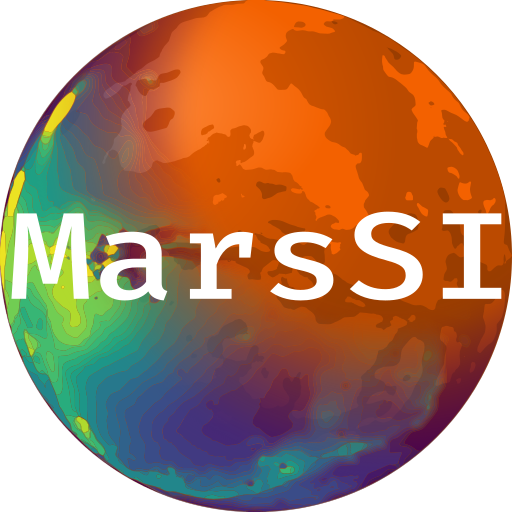Syntax highlighting of
HiRISE
{{https://upload.wikimedia.org/wikipedia/commons/2/2b/HiRISE_Flight_Structure.jpg||align="right",width="240"}}
The High Resolution Imaging Science Experiment (HiRISE) is a telescope working in orbit in the visible wavelengths and producing high resolution images resolving surface details down to 1-meter size (0.25 to 1.3 m/px). The images enable to study for instance the martian geomorphology but also seasonal surface changes.
<<TableOfContents()>>
== Instrument description ==
The HiRISE camera has 3 different color filtered CCDs: red (“RED”) from 570-830 nm, blue-green (“BG”) less than 580 nm and near-infrared (“IR”) greater than 790 nm. The high-resolution color images enable to distinguish the composition and albedo heterogeneities directly correlated to the geomorphology, complementary to the mineralogic results from the CRISM, HRSC, OMEGA and THEMIS instruments. The RED detectors provide a wide image used for geomorphologic analysis and for stereoanalysis, while the additional detectors are used to create false-color imaging of the central of the swath only (20% of the RED swath width).
== Downloading and processing HIRISE data ==
=== Imagery ===
==== Tutorial ====
From the “Maps” tab, zoom-in on your region of interest. You can swith to the THEMIS or CTX mosaic for more precision, and then display the HiRISE layer. You can see the HiRISE products footprints that appear in pink. Use the “Select” button to choose the products you desire over an area. Use the right-click context menu to add your selection to your workspace.
{{attachment:select_hirise.jpg||width="800"}}
In the "Workspace" tab, you will see your product selection. You will notice that there is two type of subproducts: the RED channel with a higher coverage products and the COLOR products (see "Instrument description for more information about coverage and color information). HiRISE color images are downloaded calibrated and with georeferencement, there is no more processing on this data type. HiRISE RED images can be processed in different steps: first a raw product (EDR) is downloaded. It can be processed into a calibrated RDR product. The last step reproject and georeference the RDR product into a MRDR image.
Check the product status: if some data is not already done yet, select the rows you would like to request by ticking the input on the left column (you can use the "Select all" button to select all visible products) and click on the "Process" action on the top of the workspace table. You can check more information about the processing in the job tab if needed.
Once all the data you would like is done, select entries by ticking the input on the left column (you can use the "Select all" button to select all visible products) and click on the "Copy" action to request a copy of the data in your personal directory. You can then proceed to download products as described in the SFTP section.
==== Pipeline information ====
The pipeline for the topographic mapping derived from HiRISE images uses both the USGS ISIS system (the ISIS 3 system).
=== Digital Elevation Model ===
==== MarsSI DEM ====
{{{#!wiki important
In order to realize a HiRISE DEM, you must have proceeded through all the HiRISE
imagery processing steps, described in the previous section.
}}}
The HiRISE DTM images created by MarsSI are generated using the NASA AMES Stereo
Pipeline (http://ti.arc.nasa.gov/tech/asr/intelligent-robotics/ngt/stereo/).
From the “Maps” tab, zoom-in on your region of interest, you can display the THEMIS mosaic for more precision, and then display the HiRISE stereo layer. You get all areas where MarsSI proposes to compute a HiRISE DEM, appearing in light blue. The footprints are regularly updated to take into account new data. You can use for example the select button to choose the footprint you desire.
{{attachment:view_hirise_stereo_layer.png||width="800"}}
To add your desired footprints to your cart click on “Add” in the “Cart” window: you can notice in the “Cart” window that three data were added, the two overlapping EDR images that will be used, and the EDTM file that will be computed. Then go to the “Workspace” tab.
Your images and DTM appear in the window “Data to process”. If not, you may already have processed it yourself, or someone else may have processed it, then it may already be in the “Data processed” window. If the images have not been processed, you will have to go through several steps:
1. Download the HiRISE EDR image (raw data) to the MarsSI server and create a calibrated RDR image as described previously.
2. Create the DTM by processing the proposed EDTM data in the “Data to process” window which may take few hours, depending on the length of the overlapping images.
When these different steps are done, the ALEDTM is waiting for you in the “Data processed” window and you can copy it to your personal data directory.
{{{#!wiki warning
The DEM footprints have been created automatically based on the percentage of intersection and the difference in emission angle between the two input images. Please be advised that DEM creation process can fail due to other parameters. See [[DemErrors]] for more information.
}}}
==== HiRISE team DEM ====
This dataset was created using the commercial stereogrammetric software SOCET SET and tuned by hand by the HiRISE team. The DTMs have a 1-meter spatial resolution and 25 cm vertical precision. For more details about the process used to create HiRISE DTMs, see [[http://onlinelibrary.wiley.com/wol1/doi/10.1029/2007JE003000/full|Kirk, R.L. et al. (2008)]].
{{attachment:view_hirise_team_stereo_layer.png||width="800"}}
== Data description ==
Data file description:
* `PSP_005000_1000_RED.JP2` (grayscale mosaic of all RED-filter channels)
* `PSP_005000_1000_COLOR.JP2` (IR, RED, BG 3-color product over center 20% of the RED swath width)
Each JP2 image also has a PDS label (.lbl) providing useful information about the observation such as map projection and viewing information.
== References ==
* HiRISE instrument and data website: http://hirise.lpl.arizona.edu
* HiRISE DTM creation explanation: http://www.uahirise.org/dtm/about.php
* HiRISE instrument description paper: McEwen, A. et al. (2007). J. Geophys. Res., 112, E05S02, doi:10.1029/2005JE002605.
* HiRISE DTM description paper: Kirk, R.L. et al. (2008). J. Geophys. Res., 113, E00A24, doi:10.1029/2007JE003000.
* Additional information about AMES Stereo Pipeline products can be found in: http://byss.ndc.nasa.gov/stereopipeline/binaries/asp_book-2.5.0.pdf
